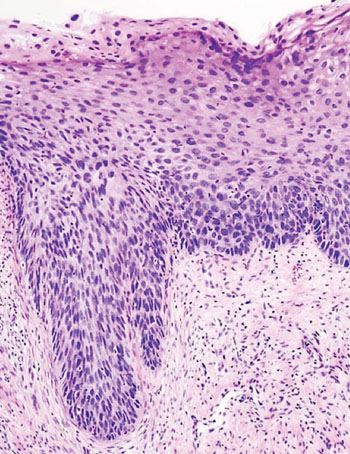Clinical Results Presented for Urine-Based High-Risk HPV Assay
By LabMedica International staff writers
Posted on 25 Sep 2014
Two pilot studies have demonstrated that a urine-based assay for the detection of high-risk human papillomavirus (HR-HPV) had high sensitivity for identifying women with high grade cervical intraepithelial neoplasia (CIN2/3).Posted on 25 Sep 2014
Assay performance was comparable to traditional HPV testing with commercially available tests in patient-matched cervical samples and in one of these studies, urine collection has been examined to establish standardization of urine as a clinical specimen for high-risk HPV testing.

Image: Histopathology of cervical intraepithelial neoplasia (CIN3) showing severe dysplasia that spans more than 2/3 of the epithelium, and may involve the full thickness. This lesion may sometimes also be referred to as cervical carcinoma in situ (Photo courtesy of KGH/Wikipedia Commons).
Scientists at the University of Oklahoma Health Sciences Center (Oklahoma City, OK, USA) studied a total of 72 women with abnormal cervical cancer screening results that had been referred to a colposcopy clinic. Urine samples had been collected from each patient prior to undergoing a pelvic exam to obtain a cervical sample. In urine samples, the high-risk HPV assay was superior to a commercially available HPV test for the identification of high-risk HPV positive women with CIN2/3. When comparing patient-matched urine samples with cervical specimens for the identification of high-risk HPV positive women with CIN2/3, the HR-HPV assay was comparable to traditional HPV testing from cervical specimens.
The high-risk HPV urine assay is a product of Trovagene, Inc. (San Diego, CA, USA) and was used in another study conducted at University of North Carolina (Chapel Hill, USA). A total of 37 women referred to a colposcopy clinic due to abnormal cervical cell cytology or persistent HPV infections were evaluated. The detection rate of high-risk HPV from a urine sample by the HR-HPV assay was not affected by the time of day when the urine sample was collected, or whether an initial versus mid-stream urine sample was used. Additionally, this study showed that women preferred providing a urine sample over brush self-collection of a cervical sample for HPV testing. Urine samples are clinically practical and preferred. Finally, a comparison of patient-matched urine samples versus cervical samples for the identification of high-risk HPV positive women with CIN2/3 found that the Trovagene HR-HPV assay, when using a urine sample, was comparable to traditional HPV testing of cervical samples using a commercially available kit.
Jennifer S. Smith, PhD, MPH, a principal investigator of the study, said, “Trovagene's urine-based high-risk HPV assay showed high sensitivity for the detection of high-grade cervical lesions among this group of colposcopy patients from North Carolina. Given women's stated preference for urine-based sampling, these results are encouraging for larger validation studies to be conducted in non-colposcopy populations, particularly because urine-based sampling is likely to reduce both logistical and acceptability barriers when screening hard-to-reach populations.” The studies were presented at the 29th International Papillomavirus (IPV) Conference held August 21–25 2014, in Seattle (WA, USA).
Related Links:
University of Oklahoma Health Sciences Center
Trovagene, Inc.
University of North Carolina













